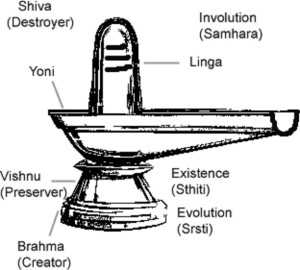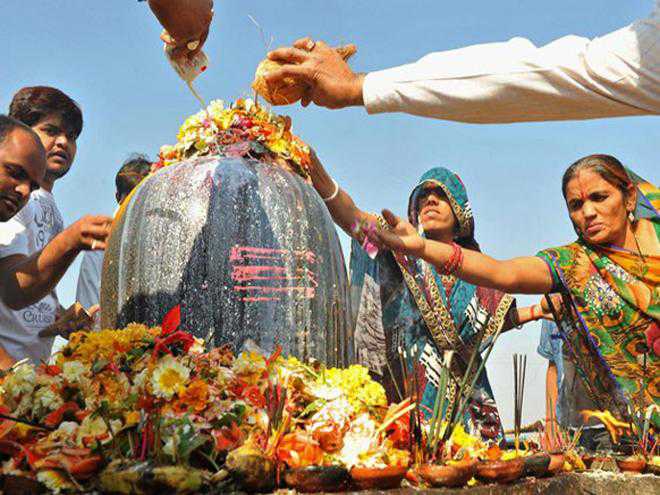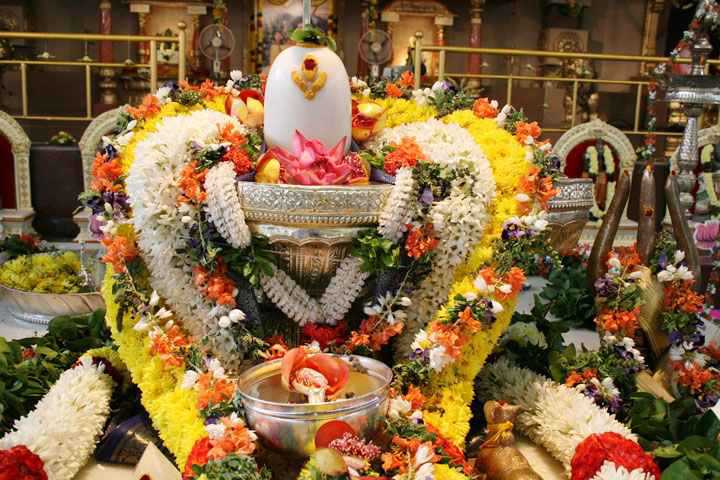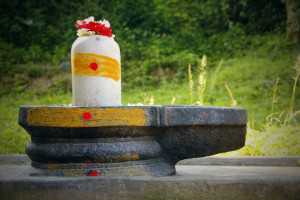No products in the cart.
Shiva Lingam is the most prevalent icon of lord Shiva and is virtually found in all Shiva temples. A holy and divine symbol of the lord, which is considered sacred by the devotees of the lord Shiva or by the Shaivaites. In fact worship of this Linga is considered superior as it helps us believe that god does not have any definite form yet he is so powerful .
Architecture of Shiva Lingam
 The Shiva Lingam is rounded , elliptical iconic image set on a circular base or Peetham or the parashakthi , the manifesting power of the god. The lingas are usually made up of stone some of which are carved accordingly while the others are naturally existing called the Svayambhu and gets shaped by a swift flowing river. Some lingas can also be made of metal, precious stones, gems, wood or transitory material like ice. Some literature believe that the transitory Shiva linga can be made from 12 different materials like from sand, rice, cooked food, river clay, cow dung, butter, rudraksha seeds, ashes, sandalwood, darbha grass, a flower garland or molasses. The supreme lord does not have any form and in fact every form is his form. Just like how when we see smoke we know that there is fire , the very moment we see a Shiva lingam we can visualise the presence of the ultimate and supreme lord.
The Shiva Lingam is rounded , elliptical iconic image set on a circular base or Peetham or the parashakthi , the manifesting power of the god. The lingas are usually made up of stone some of which are carved accordingly while the others are naturally existing called the Svayambhu and gets shaped by a swift flowing river. Some lingas can also be made of metal, precious stones, gems, wood or transitory material like ice. Some literature believe that the transitory Shiva linga can be made from 12 different materials like from sand, rice, cooked food, river clay, cow dung, butter, rudraksha seeds, ashes, sandalwood, darbha grass, a flower garland or molasses. The supreme lord does not have any form and in fact every form is his form. Just like how when we see smoke we know that there is fire , the very moment we see a Shiva lingam we can visualise the presence of the ultimate and supreme lord.
Myths about Shiva Lingam
However the common myth exists between people that the Shiva lingam depicts the male genital organ. However this is absolutely misleading and baseless and such irrelevant misinterpretation was done during the later part of the vedic period when the Indian literature came into the hands of the foreign scholars. Thus Shiva lingam is just a differentiating mark and certainly not a sex mark. According to the Linga Purana which states that:
प्रधानं प्रकृतिर यदाहुर्लिगंउत्तम ।
गंध-वर्ण-रसहिंनं शब्द-स्पर्शादिवर्जितं ॥
According to that it means that the lingam is devoid of colour, taste , hearing or touch and is considered as prakriti or nature.
Another very popular belief among the people is that they consider lord Shiva as a destructor only. However the nature itself is a lingam or symbol of the lord. The Shiva lingam is a clear mark of Shiva who is the creator , sustainer and the destructor.
Another quote from the Skanda Purana depicts that the whole universe is created from the supreme Shiva and it finally gets submerged there.
आकाशं लिंगमित्याहु: पृथ्वी तस्य पीठिका।
आलय: सर्व देवानां लयनार्लिंगमुच्यते ॥
(स्कन्द पुराण)
This means that the endless sky is the linga and the earth is the base. And at the end of it all the entire universe and all the gods finally merge into the Linga from where it originated.
Significance of Shiva Lingam
The Linga denotes the ascending powerful and radiating energy of consciousness and life in our nature. This energy can be seen in the mountain, the thundercloud, the trees and even in human beings. In fact the most important Shiva site in the Himalayas at the Kedarnath are rocks in the shape of small mountains. There are 12 Jyotirlingas or in other words the light forms of Shiva at 12 special temples throughout the world which is extremely well known and popular. The great enlightened sage Ramana Maharshi who stayed in the Himachals is said to be the place for fire linga of the supreme lord. The state of Tamil Nadu has lingas for the five elements mainly for earth, water, fire, air and ether at special temples in the region known as Panchabhoota Sthalam.
Just like how lord Shiva himself is considered to be pure light in its primal undifferentiated state called the Prakasha Matra , even the Shiva linga is described most often in terms of light transparent and crystal like. The linga is often considered as the pillar of light and hope. According to the Vedic rituals, they believed that fire could be made to rise in the shape of a pillar and eventually take the shape of a man. Dharma refers to something that upholds things and the Shiva linga is the universal pillar of dharma. This pillar is an inner symbol demonstrating the erect spine and the concentrated mind. With regards to the human nature there is the force of the Prana linga or the pillar which upholds the physical body to the currents that emanate from it and is thus called so. Then the deeper intelligence which provides us the power of insight to discriminate the right and wrong is called the Buddhi Linga and lastly the Atma linga is the ultimate or the determinative force of our nature that always remains steady and elevated throughout our lives and is termed as the Atma linga.
In addition the Linga and the yoni which is the standing stone and the ring base always go hand in hand . This also depicts the union of the male and female energies or the shiva and shakti principles. They also believe that the linga and yoni are united like the chakra or the wheel with the linga as the axis and the yoni as the circumference. In fact each chakra depicts the union of the Shiva Shakti energies at its particular level of manifestation with the Shiva energy running upward through the spine and the Shakti energy is the horizontal current forming the various lotuses of the chakra. Both these forces are essential to create a dynamic motion.
While practicing yoga the divine experience of the Shiva linga can create a pillar of light, energy, peace and eternity and helps to expand the mind and bring deep peace and steadiness to the heart and the soul. Even the waves of Shakthi that radiate can help us acquire grace, love and wisdom. It has been proved that the linga is one the best ways of meditation and to calm the mind and be in touch with our inner being and go way beyond all the materialistic needs, agitations and sorrows of the world. However according to the Ayurvedic treatment, they believe that the creation of the Prana linga allows deep healing and rejuvenation. The Vedic science considers the Shiva linga as the power of light behind the sun, moon , planets and the stars. In accordance with the Vastu shastra, the Shiva linga is the spiritual and the vital energy in the house that stabilizes everything.
The two common forms of the Shiva lingam are the Chala or the moveable form and the Achala or the fixed form.
Chala lingam is the one which is usually kept in the shrine at one home or is prepared temporarily with materials like sand, clay, dough and is often dispensed after the worship. Some consider that the lingas worn on the body in the form of pendent as Chala lingam and is usually made up of mercury,metals or quartz. The Achala or the fixed lingam are the ones that are installed in temples and are not moveable. There are certain rules which need to be obeyed for the Achala lingams like they need to be offered prayers at fixed time without being failed even once and complete sanctity must be maintained. They are usually made up of black stone.
The Shiva lingams that are usually made up of quartz have unique and special significance. Such lingas do not have a colour of their own but they tend to take up the colour of the object that comes in contact with it. The indescribable power of the Shiva linga is that it can induce concentration of the mind by just looking at it and that is exactly why ancient scholars and sages preferred the worship of Shiva lingam and its installation in the temples. It is believed that listen to the message of the Shiva lingam and it will say” i am one without a second”.
The worship of the Shiva linga has become an extremely popular form of worship especially among the Hindus. In fact every city, town ,village will atleast have one temple with a Shiva linga . According to the Purana there are 12 Jyotirlingas in various parts of the India and they are at Somnath in Gujarat, Mallikarjun Jyotirlinga in Srisailam, Kashi Vishwanath (UP), Trimbakeshwar Shiva Temple ( near Nasik, Maharashtra), Mahakaleshwar (MP), Omkareshwar Jyotirlinga (MP), Kedarnath (Himalaya), Baidyanath Dham (Jharkand), Rameshwaram Temple (Tamil Nadu), Nageshwar Jyotirlinga, Bhimashankar Temple, Grishneshwar Jyotirlinga. Similarly there are Panchabhoota lingams which represents the 5 elements and they are located in Kalahastisvar, Jambukesvar, Ekambaresvar, Natraja, Arujachalesvar.
Puja of Shiva Lingam

It is considered that the Shiva linga helps to connect the devotee with the supreme lord. The Linga puja helps in better understanding of the lord. Since the lord is formless and we still say that he is without a beginning and an end it might be difficult for a devotee to understand. And hence lord Shiva appeared in the form of Jyothirlinga before Brahma and Vishnu and thus is a pure symbol of the lord.
It is extremely important to be pure and hence the devotee needs to take a bath and wear clean washed clothes before commencing the puja. Hymns praising the lord are chanted to create a mood of worship followed by blowing the conch or ringing bells after sitting in front of the lingam and thus denoting the beginning of the puja. . The Panchamrit abhishekam is done where in five holy liquids is poured over the lingam which can include either water from the river Ganges, honey, sugarcane juice, milk, yogurt, ghee, seawater, coconut water, milk, fragnanat oils, rose water. Usually only milk of cow is used for the puja. While pouring the liquid Om Namah Shivaya is chanted repeatedly while others chant the lords name 108 or 1008 times. This is followed by cleaning the linga with the water from the ganges and is then smeared with sandalwood paste and is decorated with flowers. It is believed that water and sandalwood paste helps to keep the lingam cool as lord Shiva is always in a highly inflammable state. In some temples it is noticed that a cooling liquid is placed above the lingam and water constantly trickles down from it. Sweets, fruits, coconuts are offered to the lord followed by lighting of the camphor and the aarti is commenced. Ringing of the bells and blowing the conch marks the end of the puja. White ash is rubbed on the forehead of the linga and it is distributed among the devotees.







